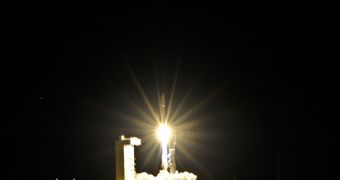Officials with the US National Reconnaissance Office (NRO) confirm the successful launch of yet another spy satellite for the United States, on Thursday, December 5. The spacecraft, whose payload and mission are classified, will probably boost the nation's ability to survey enemy targets.
The spacecraft was delivered to an unspecified orbit by a United Launch Alliance (ULA) Atlas V 501 heavy-lift delivery system, which took off from the US Air Force (USAF) Vandenberg Air Force Base, in California, at 11:14 pm PST Thursday (0714 GMT Friday, December 6), Space reports.
This was the eighth in a string of perfect launches for Atlas V in 2013. The rocket is one of the most efficient and widely used in the world today. This year alone, it flawlessly launched missions for NASA, the NRO and the US Department of Defense (DOD).
Based on the type of rocket configuration used for the launch, and the trajectory of the delivery system as it left the launch pad, amateur astronomers were able to determine that the new satellite was probably injected in the same type of orbit as two other spacecraft launched by NRO in 2010 and 2012.
The new flight, dubbed NROL-39, is probably the third in a series of radar surveillance satellites called Topaz, which are destined to replace the aging Onyx constellation. This is hypothesized based on secret budget documents leaked by Edward Snowden, indicating that the constellation will get two more satellites.
In addition to the new spy satellite, the Atlas V rocket also carried a series of 12 cubesats as secondary payloads. The small spacecraft were built by NASA, university students and the military, comments the Vice President of the Atlas and Delta programs at ULA, Jim Sponnick.
“We are pleased we could support the NRO, NASA, and all of the associated institutions by successfully delivering these important auxiliary payloads which will test and validate new technologies for debris mitigation, propulsion, space weather, communications, on-orbit data processing and the use of commercially available components,” the official said.
The cubesats include AeroCube 5, ALICE, SNaP, TacSat 6 and two SMDC-ONE, CUNYSAT 1, IPEX and MCubed 2, and FIREBIRD 1A and 1B.

 14 DAY TRIAL //
14 DAY TRIAL //